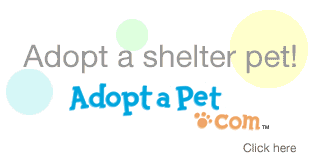Here's a great article that I thought I would pass on...hope you find it interesting! –Kim
The Sport of Dancing Dogs
by KarenC
 In the early 1990's the sport of Dog Dancing began. Since then, it has only gotten more popular. Women play the primary role in the sport. Some men are catching onto the fun and beginning to really strut their stuff. The sport of Dog Dancing practically screams out the necessity of wearing costumes.
In the early 1990's the sport of Dog Dancing began. Since then, it has only gotten more popular. Women play the primary role in the sport. Some men are catching onto the fun and beginning to really strut their stuff. The sport of Dog Dancing practically screams out the necessity of wearing costumes.The pair do their dancing to music performing intricate moves. It is a fun sport for the performers and the spectators. The dog handler chooses their music and choreographs their movements based on basic obedience. The training is excellent for the dog and fun for the owner, bringing the dog and owner into a closer relationship.
#1 Dog Dancing Team in the World: Carolyn Scott & Rookie
When I First Saw Dog Dancing!
When I saw Dog Dancing for the first time on video, I got chills. It was so inspiring. You could tell the team, dog and handler, had a long standing relationship. They could never have done such an exciting routine without time and patience getting there. It was wonderful to see. After watching these Dancing Dogs, I wanted to learn to dance with my dog. Both the owner and the dog looked like they were having loads of fun. I use to show in dog obedience trials. There is a lot of training involved.
In the more advanced levels, the dog has to jump, sniff out articles, stay in place with the owner out of sight and many other accomplishments. But,it's so stilted compared to Dog Dancing. I'm also familiar with musical freestyle with horses. Dog Dancing is very much the same. Both, canine dancing and equine musical freestyles remind me of ballroom dancing. There's a lot of feeling and expression when it's done right. This is great teamwork. What a relationship they must have.
When I saw Dog Dancing for the first time on video, I got chills. It was so inspiring. You could tell the team, dog and handler, had a long standing relationship. They could never have done such an exciting routine without time and patience getting there. It was wonderful to see. After watching these Dancing Dogs, I wanted to learn to dance with my dog. Both the owner and the dog looked like they were having loads of fun. I use to show in dog obedience trials. There is a lot of training involved.
In the more advanced levels, the dog has to jump, sniff out articles, stay in place with the owner out of sight and many other accomplishments. But,it's so stilted compared to Dog Dancing. I'm also familiar with musical freestyle with horses. Dog Dancing is very much the same. Both, canine dancing and equine musical freestyles remind me of ballroom dancing. There's a lot of feeling and expression when it's done right. This is great teamwork. What a relationship they must have.
What is Canine Freestyle?
The World Canine Freestyle Association defines canine freestyle as follows:
"Musical Freestyle is a choreographed musical program performed by handlers and their dogs. The object of musical freestyle is to display the dog and handler in a creative, innovative and original dance, using music and intricate movements to showcase teamwork, artistry, costuming, athleticism and style in interpreting the theme of the music. Heelwork-to-Music incorporates traditional dog obedience and the art of dressage with the inclusion of musical interpretation, dance elements, and costuming with an emphasis on non-standard obedience movements. Both Musical Freestyle and Heelwork-to-Music routines should create a visually exciting display which is enjoyable to watch and which is equally enjoyable to dogs and handlers executing the programs. Canine freestyle is a showcase that truly demonstrates the joys and fun of bonding with your pet."
Getting Started in Canine Freestyle
It all starts with basic obedience training, only with a twist. In basic obedience, the dog heels only on one side. With Freestyle the dog needs to be trained to heel on either side. Also, with all other routine training, the dog should perform on one side as well as the other. It is best to train your dog to have his attention on you. During the dance routines, your dog will need to take his cues from you. Other beginning training should include backing in a straight line, pivoting in place, and side stepping.
Remember to practice both directions and both sides as well as in front of you. The aim is to show off your dog's grace, beauty and athleticism. Once the basics are in place, start practicing to music. Experiment with the different moves seeing how much distance you cover together in a side pass. You want to make good use of about a 40 X 50 foot area. Get your dog happy. Move with the beat. You will find your relationship with your dog growing. There's nothing like Freestyle to improve your dog's attitude and attention. Find out what Canine Freestyle events are coming soon. Visit the Canine Freestyle Federation, Inc.
Some Required Moves
It all starts with basic obedience training, only with a twist. In basic obedience, the dog heels only on one side. With Freestyle the dog needs to be trained to heel on either side. Also, with all other routine training, the dog should perform on one side as well as the other. It is best to train your dog to have his attention on you. During the dance routines, your dog will need to take his cues from you. Other beginning training should include backing in a straight line, pivoting in place, and side stepping.
Remember to practice both directions and both sides as well as in front of you. The aim is to show off your dog's grace, beauty and athleticism. Once the basics are in place, start practicing to music. Experiment with the different moves seeing how much distance you cover together in a side pass. You want to make good use of about a 40 X 50 foot area. Get your dog happy. Move with the beat. You will find your relationship with your dog growing. There's nothing like Freestyle to improve your dog's attitude and attention. Find out what Canine Freestyle events are coming soon. Visit the Canine Freestyle Federation, Inc.
Some Required Moves
The art of Dog Dancing has quite a few classy moves for dog and handler to practice. Here are some of the basic required moves:
- Heeling: the dog stays by your side.
- Turns: When you turn your dog stays at your side.
- Pivots: Turning in place with your dog at your side.
- Frontwork: The dog is in front of the handler with his body straight and centered on the handler.
- Side Pass: Moving to the right or left with dog and handler remaining parallel, dog remaining straight from head to tail.
- Distance Work: Moving with at least 6 feet between dog and handler.
- Pace Changes: Walk to run to walk are pace chenges.
- Various Other Movements: Stepping in place, Weaving, Rollover, Crawl, Jump and Spin.
- Make Up Your Own: There's always room for innovative thinking. Make up a new dance step.
Creative Potential in Dog Freestyle
In Dog Freestyle, there is a huge potential for creativity. The possibilities are limited only by you and your dog. The idea is to show your dog off to advantage. The dog performs a variety of tricks and other obedience abilities. The trainer's dance abilities and creativness are key points in freestyle. It's very important the routine flow with the music chosen. The main focus is to be on the dog. If the handler does most of the movements to the music, the focus moves to the handler and is taken off of the dog. This is frowned upon in canine musical freestyle because this is suppose to be a dog sport.
It's important that the dog look graceful and comfortable in the movements. Between changing speeds, varying movements and adding different jumps, twists and turns, you can create different routines. Don't forget your dog can have a say, too. If you watch how your dog acts, you may pick up on some cute, funny or absolutely fantastic moves. It's a partnership. Let your dog be as creative as you. Have fun!
Source: Dancing Dogs Squidoo




































